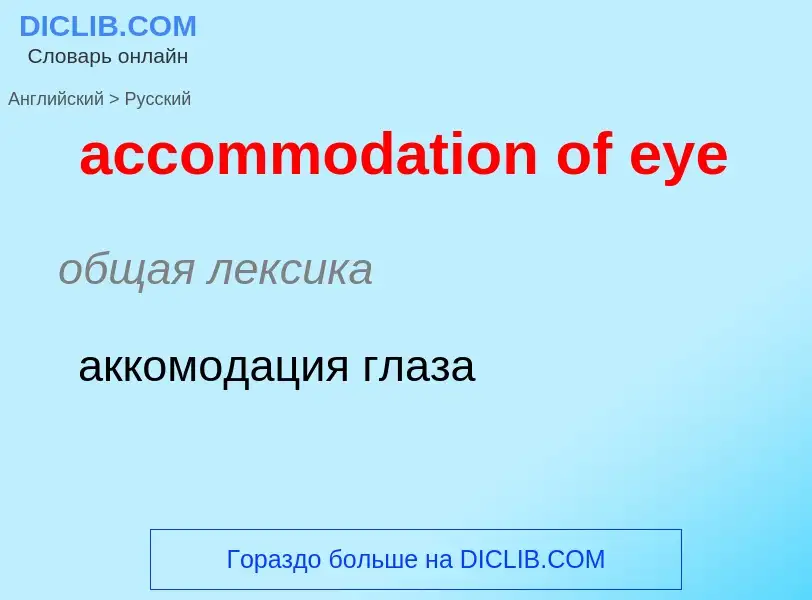Tradução e análise de palavras por inteligência artificial ChatGPT
Nesta página você pode obter uma análise detalhada de uma palavra ou frase, produzida usando a melhor tecnologia de inteligência artificial até o momento:
- como a palavra é usada
- frequência de uso
- é usado com mais frequência na fala oral ou escrita
- opções de tradução de palavras
- exemplos de uso (várias frases com tradução)
- etimologia
accommodation of eye - tradução para russo
общая лексика
аккомодация глаза
['aiwɔ:l]
метеорология
облачный вихрь вокруг ядра тайфуна
"глаз бури"
существительное
метеорология
облачный вихрь вокруг ядра тайфуна
«глаз бури»
общая лексика
бытовка
бытовое помещение
Definição
.
Wikipédia
Accommodation is the process by which the vertebrate eye changes optical power to maintain a clear image or focus on an object as its distance varies. In this, distances vary for individuals from the far point—the maximum distance from the eye for which a clear image of an object can be seen, to the near point—the minimum distance for a clear image. Accommodation usually acts like a reflex, including part of the accommodation-vergence reflex, but it can also be consciously controlled. Mammals, birds and reptiles vary their eyes' optical power by changing the form of the elastic lens using the ciliary body (in humans up to 15 dioptres in the mean). Fish and amphibians vary the power by changing the distance between a rigid lens and the retina with muscles.
The young human eye can change focus from distance (infinity) to as near as 6.5 cm from the eye. This dramatic change in focal power of the eye of approximately 15 dioptres (the reciprocal of focal length in metres) occurs as a consequence of a reduction in zonular tension induced by ciliary muscle contraction. This process can occur in as little as 224 ± 30 milliseconds in bright light. The amplitude of accommodation declines with age. By the fifth decade of life the accommodative amplitude can decline so that the near point of the eye is more remote than the reading distance. When this occurs the patient is presbyopic. Once presbyopia occurs, those who are emmetropic (i.e., do not require optical correction for distance vision) will need an optical aid for near vision; those who are myopic (nearsighted and require an optical correction for distance or far vision), will find that they see better at near without their distance correction; and those who are hyperopic (farsighted) will find that they may need a correction for both distance and near vision. Note that these effects are most noticeable when the pupil is large; i.e. in dim light. The age-related decline in accommodation occurs almost universally to less than 2 dioptres by the time a person reaches 45 to 50 years, by which time most of the population will have noticed a decrease in their ability to focus on close objects and hence require glasses for reading or bifocal lenses. Accommodation decreases to about 1 dioptre at the age of 70 years. The dependency of accommodation amplitude on age is graphically summarized by Duane's classical curves.


![The eye of [[Hurricane Katrina]] viewed from a [[hurricane hunter]] aircraft The eye of [[Hurricane Katrina]] viewed from a [[hurricane hunter]] aircraft](https://commons.wikimedia.org/wiki/Special:FilePath/Fly00449 - Flickr - NOAA Photo Library.jpg?width=200)
![[[Hurricane Wilma]] with a pinhole eye [[Hurricane Wilma]] with a pinhole eye](https://commons.wikimedia.org/wiki/Special:FilePath/HurricaneWilma20Oct2005.jpg?width=200)
![Detailed view of hurricane Isabel's eye, as viewed from the [[International Space Station]] Detailed view of hurricane Isabel's eye, as viewed from the [[International Space Station]]](https://commons.wikimedia.org/wiki/Special:FilePath/Hurricane Isabel eye from ISS (edit 1).jpg?width=200)
![Hurricane Emilia]] in 1994. Hurricane Emilia]] in 1994.](https://commons.wikimedia.org/wiki/Special:FilePath/Hurricane emilia (1994) eye close-up.jpg?width=200)
![Typhoon Maysak's]] eye from the [[International Space Station]] on March 31, 2015, displaying a pronounced stadium effect. Typhoon Maysak's]] eye from the [[International Space Station]] on March 31, 2015, displaying a pronounced stadium effect.](https://commons.wikimedia.org/wiki/Special:FilePath/Maysak seen from the ISS 3.jpg?width=200)

